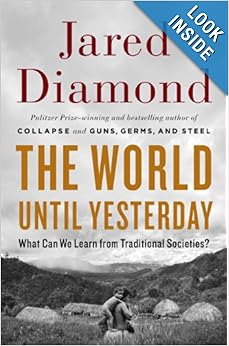 In a mixed review of evolutionary biologist, Jared Diamond’s latest, reviewer James C. Scott discusses a key point you don’t hear often in the pop science media (except when the fort must be defended against same):
In a mixed review of evolutionary biologist, Jared Diamond’s latest, reviewer James C. Scott discusses a key point you don’t hear often in the pop science media (except when the fort must be defended against same):
What were our ancestors like before the domestication of plants and animals, before sedentary village life, before the earliest towns and states? That is the question Diamond sets himself to answer. In doing so, he faces nearly insurmountable obstacles. Until quite recently, archaeology recorded our history as a species in relation to the concentration of debris (middens, building rubble, traces of irrigation canals, walls, fossilised faeces etc) we left behind. Hunter-gatherers were typically mobile and spread their largely biodegradable debris widely; we don’t often find their temporary habitats, which were often in caves or beside rivers or the sea, and the vast majority of such sites have been lost to history. When we do find them, they can tell us something about their inhabitants’ diet, cooking methods, bodily adornment, trade goods, weapons, diseases, local climate and occasionally even causes of death, but not much else. How to infer from this scant evidence our ancestors’ family structure and social organisation, their patterns of co-operation and conflict, let alone their ethics and cosmology?
It is here that Diamond makes his fundamental mistake. He imagines he can triangulate his way to the deep past by assuming that contemporary hunter-gatherer societies are ‘our living ancestors’, that they show what we were like before we discovered crops, towns and government. This assumption rests on the indefensible premise that contemporary hunter-gatherer societies are survivals, museum exhibits of the way life was lived for the entirety of human history ‘until yesterday’ – preserved in amber for our examination.
In the unique case of Highland New Guinea, which was apparently isolated from coastal trade and the outside world until World War Two, Diamond might be forgiven for making this inference, though the people of New Guinea have had exactly the same amount of time to adapt and evolve as homo americanus and they managed somehow to get hold of the sweet potato, which originated in South America. The inference of pristine isolation, however, is completely unwarranted for virtually all of the other 35 societies he canvasses. Those societies have, for the last five thousand years, been deeply involved in a world of trade, states and empires and are often now found in undesirable marginal areas to which they have been pushed by more powerful societies.
But they were still, as anthropologist Scott goes on to point out, still “up to their necks in the civilised world.”
It would be interesting to see what percentage of writings on “evolutionary psychology” would mysteriously disappear if evidence from contemporary hunter-gatherer societies were banned on the grounds that they may be relatively recent creations.
For one thing, under those circumstances it is not at all clear that a society can exist that way “for thousands of years” or that their lifestyle is “in our genes” because it “enables us to leave fertile offspring.” It may be just what some groups of people under pressure decided to do because it felt like the best solution at the time.